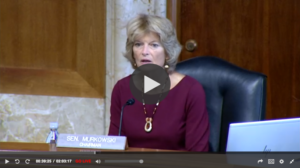US Senators Show Strong Interest in Ammonia-Fueled Shipping
By Jonathan Lewis on October 08, 2020
A guest editorial by Jonathan Lewis, Senior Counsel at Clean Air Task Force.
The Senate Energy and Natural Resources Committee, led by Chairman Lisa Murkowski (R-Alaska) and Ranking Member Joe Manchin (D-West Virginia), recently hosted a hearing on offshore energy technologies. I was invited to testify on technology and policy options for eliminating greenhouse gas emissions from the marine shipping sector, and I used the opportunity to spotlight ammonia’s central role in that effort.
Although marine shipping issues are not a regular part of the Committee’s business, members and their staff—even those representing landlocked states—were eager to dive in. Senators were quick to recognize that ammonia can be made throughout the United States using a variety of resources and technologies, and that a transition to hydrogen-based fuels in the marine sector and elsewhere would generate important economic and environmental benefits.

In my testimony, I told the Committee that to avoid the worst impacts of climate change we need to eliminate greenhouse gas emissions from nearly every major sector of the global economy by 2050—including the shipping sector, which emits more greenhouse gas each year than Germany, the United Kingdom, or South Korea.
Eliminating those emissions will require a shift to zero carbon fuels, specifically hydrogen and ammonia. I explained that they emit no carbon dioxide when converted to energy, and that the production of both fuels is massively scalable because the ingredients for hydrogen and ammonia are readily obtainable and nearly inexhaustible. I outlined the options for producing these zero carbon fuels through zero-carbon processes, starting with the installation of carbon capture and sequestration systems at methane reformers that use natural gas to make hydrogen, in combination with effective emission controls across the natural gas production, transport, and distribution system. Electrolysis, of course, will make a huge contribution here, too, just as soon as the systems are available. I explained that if a zero-carbon power source is used to generate the electricity (such as solar, wind, or nuclear power), electrolytic production of hydrogen results in zero lifecycle carbon emissions.
I identified ammonia as a particularly compelling candidate for fuel-shifting in the marine shipping sector. Ammonia is relatively easy to store and transport, and appears to be compatible with retrofitted and purpose-built internal combustion engines, which might limit the extent to which existing energy systems need to be wholly replaced. Ports already site and build ammonia storage and handling equipment, thereby mitigating the chicken-and-egg challenges that often complicate the transition to alternative fuels.
My testimony concluded with a summary of steps that Congress can take to support the development and scale-up of zero carbon fuels. These include:
- Reducing technology costs by directing the US Department of Energy to sponsor research, development, and deployment of ammonia reciprocating engines, high-temperature electrolysis, and other critical technologies.
- Directing federal support to zero carbon fuel production, infrastructure build-out, and end-use technology adoption through production and investment tax credits; through rebates and incentives for zero carbon fuel end-use technologies; and through tax credits for pipelines, terminals, storage tanks, and other infrastructure for zero carbon fuels.
- Kickstarting zero carbon fuels and marine shipping decarbonization through development loans and cost-share grants that facilitate the development of key zero carbon fuel production, transport, and end-use hubs across the United States.
Senators jumped in with questions on topics ranging from the ability to make existing marine engines ammonia-compatible to the impacts of zero carbon fuels on economic development and employment. On that second point, Senator Catherine Cortez Mastro of Nevada asked me to elaborate on the opportunities that marine sector demand for zero carbon fuels might create in her landlocked state. I responded that a key attribute of hydrogen and ammonia fuels is that they can be produced at commercial scale in a variety of places and in a variety of ways.
We think it’s likely that scale-up in zero-emission hydrogen production is going to be achieved through the use of expanded renewable energy power, nuclear power, and gas reforming with carbon capture.
Some of the jobs associated with this scale-up involve new technologies and new skill sets while others are going to be pretty similar to jobs that already exist in the petrochemical industry. Ultimately, we’re going to need to produce liquid and gaseous fuels using technologies that are similar in many ways to conventional refineries but do a better job managing carbon flows. Those are large installations that require people to build and to run them.
Jonathan Lewis, oral testimony to the US Senate Committee on Energy and Natural Resources, Full Committee Hearing on Offshore Energy Technologies, September 22, 2020
The full hearing can be viewed here. [The 2-hour archive webcast includes the oral summary of testimony by Jonathan Lewis (1:05); his exchange on shipping with Ranking Member Manchin of West Virginia (1:16); his exchange on jobs with Senator Cortez-Masto of Nevada (1:36); his discussion of ammonia vs. hydrogen in shipping with Senator King of Maine (1:50).]
Clean Air Task Force looks forward partnering with fellow members of the Ammonia Energy Association as we work with the Senate Energy and Natural Resources Committee and other policymakers on steps that can be taken to develop and deploy zero carbon fuels.
Jonathan Lewis is Senior Counsel at Clean Air Task Force, a nonprofit organization that advocates for the change in technologies and policies needed to get to a zero-emissions, high-energy planet at an affordable cost, so that we can meet the world’s rising energy demand in a way that is financially, socially and environmentally sustainable.